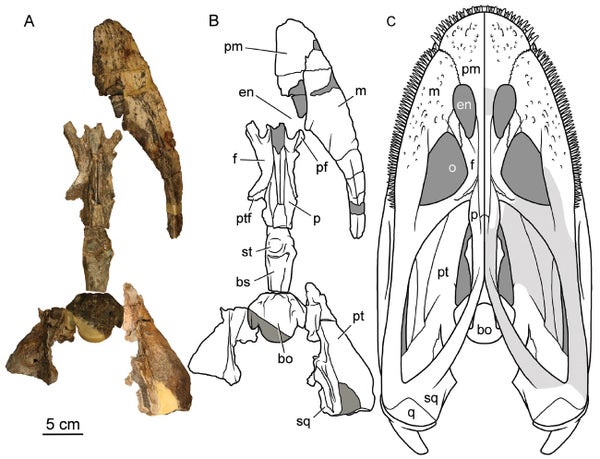This article was published in Scientific American’s former blog network and reflects the views of the author, not necessarily those of Scientific American
What did plesiosaurs eat? When I was a kid, the answer was simple. Long-necked plesiosaurs like Elasmosaurus evolved their ridiculous necks to strike out at little fish and squirmy squid.
But recent discoveries have complicated the simplicity of those old images. Gut contents, as well as the mechanics of plesiosaur necks, have shown that at least some of these marine reptiles trawled along the bottom for crustaceans and other morsels. And a new analysis of one of the last plesiosaurs shows something stranger still - at least one plesiosaur evolved a way to strain tiny tidbits through its teeth.
Two years back, at the annual Society of Vertebrate Paleontology meeting in Dallas, paleontologist F. Robin O'Keefe announced the finding. Mortuneria, a plesiosaur found almost three decades ago in the roughly 66 million year old rock of Antarctica, was a filter feeder. Now the results have been officially published. The teeth tell the tale.
In most plesioaurs, the conical teeth of the upper jaw jut downwards and the teeth of the low jaw rise up to meet them, giving them snaggletoothed grins. But in Morturneria, O'Keefe and colleagues report, the needle-like teeth of the lower jaw angle out to the side and bend downwards, meshing with the upper teeth to make a sieve. No one has seen anything quite like this in a marine reptile before.
And there's more. The jaws of Morturneria were relatively weak - not at all suited to holding struggling prey - and the hoop-shaped lower jaw increased the volume of water this plesiosaur was able to take into its mouth. The anatomy of the reptile, then, indicates that Morturneria was able to do what some experts said plesiosaurs couldn't do - it was a suspension feeder, a marine reptile that evolved a unique way to strain food from the water.
On supporting science journalism
If you're enjoying this article, consider supporting our award-winning journalism by subscribing. By purchasing a subscription you are helping to ensure the future of impactful stories about the discoveries and ideas shaping our world today.
Precisely how Morturneria went about feeding is still open to investigation. But, from the anatomy of the skull and jaws, O'Keefe and coauthors propose that Morturneria scooped up sediment and then, holding its jaws slightly open, somehow pumped out the sediment-laden water and trapped amphipods and other small prey with its teeth. This would've made Morturneria the Cretaceous equivalent of a gray whale, a reptile who was sifting the seas before the ancestors of cetaceans even began to enter the oceans.

The skull of Morturneria as seen from the top. Credit: O'Keefe et al 2017
Fossil Facts
Name: Morturneria seymourensis
Meaning: Morturneria honors geologist Mort Turner, while seymourensis is after the Antarctic island the fossils were found on.
Age: Cretaceous, about 66 million years ago.
Where in the world?: Seymour Island, Antarctica.
What sort of organism?: An elasmosaurid plesiosaur.
How much of the organism’s is known?: A partial skull and associated neck vertebrae.
References:
Chatterjee, S., Small, B. 1989. New plesiosaurs from the Upper Cretaceous of Antarctica. Geological Society Special Publication. doi: 10.1144/GSL.SP.1989.047.01.15
O'Keefe, F., Otero, R., Soto-Acuña, S., O'gorman, J., Godfrey, S., Chatterjee, S. 2017. Cranial anatomy of Morturneria seymourensis from Antarctica, and the evolution of filter feeding in plesiosaurs of the Austral Late Cretaceous. Journal of Vertebrate Paleontology. doi: 10.1080/02724634.2017.1347570
Previous Paleo Profiles:
The Light-Footed Lizard The Maoming Cat Knight’s Egyptian Bat The La Luna Snake The Rio do Rasto Tooth Bob Weir's Otter Egypt's Canine Beast The Vastan Mine Tapir Pangu's Wing The Dawn Megamouth The Genga Lizard The Micro Lion The Mystery Titanosaur The Echo Hunter The Lo Hueco Titan The Three-Branched Cicada The Monster of Minden The Pig-Footed Bandicoot Hayden's Rattlesnake Demon The Evasive Ostrich Seer The Paradoxical Mega Shark The Tiny Beardogs The Armored Fish King North America's Pangolin The Invisible-Tusked Elephant The Mud Dragon The Spike-Toothed Salmon The Dream Coast Crocodile Buriol's Robber Ozimek's Flyer The Northern Naustoceratopsian The High Arctic Flyer The Tomatillo From the End of the World The Short-Faced Hyena The Mighty Traveler from Egg Mountain Keilhau's Ichthyosaur Mexico's Ancient Horned Face Mauricio Fernández's Plesiosaur New Zealand's Giant Dawn Penguin The Orange Sea Lion Mongolia's Ginkgo Cousin The Geni River Frog Isabel Berry's Dinosaur The Whale Caiman The Moab Lizard Yang Zhongjian's Lizard The Little Anubis The Shuangbai Lizard The Wyvern Dinosaur The "Need Helmet" Dinosaur The Jianianhua Dragon The Liaoning Hunter The Dalian Lizard Crompton's Aleodon Jenkins' Amphibian Serpent From the Chinle The Large Ancestor Lizard The Crown Tooth Currie's Alberta Hunter The Elephant Bird Mimic The Crested Thief The Hiding Hunter The Horned Lizard The Silk Bird